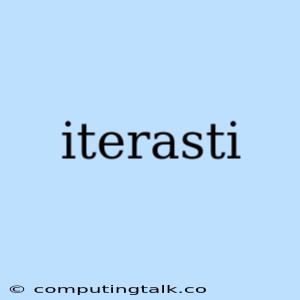Iteration is a fundamental concept in computer programming and software development. It refers to the process of repeating a set of instructions or a block of code multiple times. This repetition is often controlled by a loop, which allows the code to execute a specific number of times or until a certain condition is met.
Why is Iteration Important?
Iteration plays a crucial role in making code more efficient and reusable. Instead of writing the same code multiple times, you can use a loop to execute it repeatedly, saving you time and effort. Here's why iteration is essential:
- Automation: Iteration automates repetitive tasks, freeing up developers to focus on more complex aspects of the code.
- Data Processing: Iteration is crucial for processing large amounts of data. Loops can iterate through each data item and perform operations on it.
- Pattern Recognition: Iteration allows you to identify patterns in data or code and apply logic based on those patterns.
- Flexibility: Iterative loops can be controlled with conditions, allowing you to adjust the number of iterations based on specific criteria.
Types of Loops
Common types of loops used in programming languages include:
- For Loop: This loop executes a block of code a fixed number of times. It's used when you know the exact number of iterations needed.
- While Loop: This loop executes a block of code as long as a specific condition is true. It's used when the number of iterations is unknown beforehand.
- Do-While Loop: Similar to a while loop, but it always executes the code at least once before checking the condition.
Practical Applications of Iteration
Here are some practical examples of how iteration is used in programming:
- Calculating the sum of a list of numbers: A loop can iterate through the list and add each number to a running total.
- Finding the maximum value in an array: A loop can iterate through the array and compare each element to the current maximum value.
- Generating a sequence of numbers: A loop can increment a counter and generate a series of numbers.
- Reading data from a file: A loop can read lines of text from a file and process them one by one.
- Displaying elements of a data structure: A loop can traverse a data structure and display its elements to the user.
Example in Python
Let's illustrate iteration with a simple Python example:
# Calculate the sum of numbers from 1 to 10
total = 0
for i in range(1, 11):
total += i
print(f"The sum of numbers from 1 to 10 is: {total}")
Debugging Iterative Code
Debugging iterative code can be tricky. Here are some tips:
- Print Statements: Insert print statements inside the loop to see the values of variables at each iteration.
- Stepping Through Code: Use a debugger to step through the code line by line and examine the state of the program at each iteration.
- Breakpoints: Set breakpoints in the code to pause execution at specific points and inspect variables.
Conclusion
Iteration is a powerful tool in the programmer's arsenal. It allows you to automate repetitive tasks, process data efficiently, and create flexible and adaptable code. By understanding the principles of iteration, you can write more concise, efficient, and maintainable programs.
